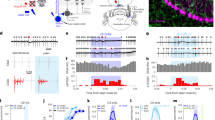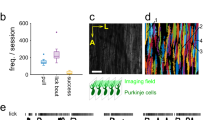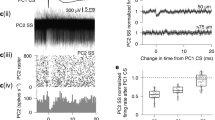Abstract
Climbing fiber inputs to Purkinje cells are thought to be involved in generating the instructive signals that drive cerebellar learning. To investigate how these instructive signals are encoded, we recorded the activity of individual climbing fibers during cerebellum-dependent eyeblink conditioning in mice. We found that climbing fibers signaled both the unexpected delivery and the unexpected omission of the periocular airpuff that served as the instructive signal for eyeblink conditioning. In addition, we observed that climbing fibers activated by periocular airpuffs also responded to stimuli from other sensory modalities if those stimuli were novel or if they predicted that the periocular airpuff was about to be presented. This pattern of climbing fiber activity is markedly similar to the responses of dopamine neurons during reinforcement learning, which have been shown to encode a particular type of instructive signal known as a temporal difference prediction error.
This is a preview of subscription content, access via your institution
Access options
Subscription info for Japanese customers
We have a dedicated website for our Japanese customers. Please go to natureasia.com to subscribe to this journal.
Buy this article
- Purchase on SpringerLink
- Instant access to full article PDF
Prices may be subject to local taxes which are calculated during checkout





Similar content being viewed by others
References
Eccles, J.C., Llinás, R. & Sasaki, K. The excitatory synaptic action of climbing fibres on the Purkinje cells of the cerebellum. J. Physiol. (Lond.) 182, 268–296 (1966).
Najafi, F. & Medina, J.F. Beyond “all-or-nothing” climbing fibers: graded representation of teaching signals in Purkinje cells. Front. Neural Circuits 7, 115 (2013).
De Zeeuw, C.I. et al. Microcircuitry and function of the inferior olive. Trends Neurosci. 21, 391–400 (1998).
Simpson, J.I., Wylie, D.R. & De Zeeuw, C.I. On climbing fiber signals and their consequence(s). Behav. Brain Sci. 19, 384–398 (1996).
Medina, J.F., Nores, W.L., Ohyama, T. & Mauk, M.D. Mechanisms of cerebellar learning suggested by eyelid conditioning. Curr. Opin. Neurobiol. 10, 717–724 (2000).
Christian, K.M. & Thompson, R.F. Neural substrates of eyeblink conditioning: acquisition and retention. Learn. Mem. 10, 427–455 (2003).
Freeman, J.H. & Steinmetz, A.B. Neural circuitry and plasticity mechanisms underlying delay eyeblink conditioning. Learn. Mem. 18, 666–677 (2011).
Thompson, R.F., Thompson, J.K., Kim, J.J., Krupa, D.J. & Shinkman, P.G. The nature of reinforcement in cerebellar learning. Neurobiol. Learn. Mem. 70, 150–176 (1998).
Sears, L.L. & Steinmetz, J.E. Dorsal accessory inferior olive activity diminishes during acquisition of the rabbit classically conditioned eyelid response. Brain Res. 545, 114–122 (1991).
Nicholson, D.A. & Freeman, J.H. Jr. Addition of inhibition in the olivocerebellar system and the ontogeny of a motor memory. Nat. Neurosci. 6, 532–537 (2003).
Rasmussen, A., Jirenhed, D.A. & Hesslow, G. Simple and complex spike firing patterns in Purkinje cells during classical conditioning. Cerebellum 7, 563–566 (2008).
Mauk, M.D., Steinmetz, J.E. & Thompson, R.F. Classical conditioning using stimulation of the inferior olive as the unconditioned stimulus. Proc. Natl. Acad. Sci. USA 83, 5349–5353 (1986).
Ito, M. Error detection and representation in the olivo-cerebellar system. Front. Neural Circuits 7, 1 (2013).
Schultz, W. & Dickinson, A. Neuronal coding of prediction errors. Annu. Rev. Neurosci. 23, 473–500 (2000).
Dean, P. & Porrill, J. Decorrelation learning in the cerebellum: computational analysis and experimental questions. Prog. Brain Res. 210, 157–192 (2014).
Rescorla, R.A. & Wagner, A.R. A theory of Pavlovian conditioning: variations in the effectiveness of reinforcement and nonreinforcement. in Classical Conditioning II: Current Research and Theory (eds. Black, A.H. & Prokasy, W.F.) 64–99 (Appleton-Century-Crofts, New York, 1972).
Widrow, B. & Hoff, M.E. Adaptive switching circuits. in IRE WESCON Convention Recored 96–104 (Institute of Radio Engineers, New York, 1960).
Mauk, M.D. & Donegan, N.H. A model of Pavlovian eyelid conditioning based on the synaptic organization of the cerebellum. Learn. Mem. 4, 130–158 (1997).
Medina, J.F. & Mauk, M.D. Computer simulation of cerebellar information processing. Nat. Neurosci. 3 (suppl. 1): 1205–1211 (2000).
Sutton, R.S. & Barto, A.G. Time-derivative models of Pavlovian reinforcement. in Learning and Computational Neuroscience: Foundations of Adaptive Networks (eds. Gabriel, M. & Moore, J.W.) 497–538 (MIT Press, Cambridge, Massachusetts, 1990).
Sutton, R.S. Learning to predict by the methods of temporal differences. Mach. Learn. 3, 9–44 (1988).
Schultz, W. Predictive reward signal of dopamine neurons. J. Neurophysiol. 80, 1–27 (1998).
Schultz, W., Dayan, P. & Montague, P.R. A neural substrate of prediction and reward. Science 275, 1593–1599 (1997).
Heiney, S.A., Wohl, M.P., Chettih, S.N., Ruffolo, L.I. & Medina, J.F. Cerebellar-dependent expression of motor learning during eyeblink conditioning in head-fixed mice. J. Neurosci. 34, 14845–14853 (2014).
Yang, Y., Lei, C., Feng, H. & Sui, J.F. The neural circuitry and molecular mechanisms underlying delay and trace eyeblink conditioning in mice. Behav. Brain Res. 278, 307–314 (2015).
Boele, H.J., Koekkoek, S.K. & De Zeeuw, C.I. Cerebellar and extracerebellar involvement in mouse eyeblink conditioning: the ACDC model. Front. Cell. Neurosci. 3, 19 (2010).
Heiney, S.A., Kim, J., Augustine, G.J. & Medina, J.F. Precise control of movement kinematics by optogenetic inhibition of Purkinje cell activity. J. Neurosci. 34, 2321–2330 (2014).
Mostofi, A., Holtzman, T., Grout, A.S., Yeo, C.H. & Edgley, S.A. Electrophysiological localization of eyeblink-related microzones in rabbit cerebellar cortex. J. Neurosci. 30, 8920–8934 (2010).
Thach, W.T. Jr. Somatosensory receptive fields of single units in cat cerebellar cortex. J. Neurophysiol. 30, 675–696 (1967).
Hesslow, G. & Ivarsson, M. Inhibition of the inferior olive during conditioned responses in the decerebrate ferret. Exp. Brain Res. 110, 36–46 (1996).
Andersson, G., Garwicz, M. & Hesslow, G. Evidence for a GABA-mediated cerebellar inhibition of the inferior olive in the cat. Exp. Brain Res. 72, 450–456 (1988).
Van Ham, J.J. & Yeo, C.H. Somatosensory trigeminal projections to the inferior olive, cerebellum and other precerebellar nuclei in rabbits. Eur. J. Neurosci. 4, 302–317 (1992).
Swenson, R.S. & Castro, A.J. The afferent connections of the inferior olivary complex in rats. An anterograde study using autoradiographic and axonal degeneration techniques. Neuroscience 8, 259–275 (1983).
Svensson, P., Bengtsson, F. & Hesslow, G. Cerebellar inhibition of inferior olivary transmission in the decerebrate ferret. Exp. Brain Res. 168, 241–253 (2006).
Llinás, R.R. Cerebellar motor learning versus cerebellar motor timing: the climbing fibre story. J. Physiol. (Lond.) 589, 3423–3432 (2011).
Chettih, S.N., McDougle, S.D., Ruffolo, L.I. & Medina, J.F. Adaptive timing of motor output in the mouse: the role of movement oscillations in eyelid conditioning. Front. Integr. Neurosci. 5, 72 (2011).
Kakade, S. & Dayan, P. Dopamine: generalization and bonuses. Neural Netw. 15, 549–559 (2002).
Laurent, P.A. The emergence of saliency and novelty responses from Reinforcement Learning principles. Neural Netw. 21, 1493–1499 (2008).
Pearce, J.M. & Hall, G. A model for Pavlovian learning: variations in the effectiveness of conditioned but not of unconditioned stimuli. Psychol. Rev. 87, 532–552 (1980).
Berthier, N.E. & Moore, J.W. Cerebellar Purkinje cell activity related to the classically conditioned nictitating membrane response. Exp. Brain Res. 63, 341–350 (1986).
Nicholson, D.A. & Freeman, J.H. Jr. Developmental changes in eye-blink conditioning and neuronal activity in the inferior olive. J. Neurosci. 20, 8218–8226 (2000).
Bengtsson, F. & Jorntell, H. Ketamine and xylazine depress sensory-evoked parallel fiber and climbing fiber responses. J. Neurophysiol. 98, 1697–1705 (2007).
Ozden, I., Dombeck, D.A., Hoogland, T.M., Tank, D.W. & Wang, S.S.-H. Widespread state-dependent shifts in cerebellar activity in locomoting mice. PLoS ONE 7, e42650 (2012).
Apps, R. Gating of climbing fibre input to cerebellar cortical zones. Prog. Brain Res. 124, 201–211 (2000).
Jörntell, H., Garwicz, M. & Ekerot, C.F. Relation between cutaneous receptive fields and muscle afferent input to climbing fibres projecting to the cerebellar C3 zone in the cat. Eur. J. Neurosci. 8, 1769–1779 (1996).
Pardoe, J., Edgley, S.A., Drew, T. & Apps, R. Changes in excitability of ascending and descending inputs to cerebellar climbing fibers during locomotion. J. Neurosci. 24, 2656–2666 (2004).
Gellman, R., Houk, J.C. & Gibson, A.R. Somatosensory properties of the inferior olive of the cat. J. Comp. Neurol. 215, 228–243 (1983).
Saint-Cyr, J.A. & Courville, J. Descending projections to the inferior olive from the mesencephalon and superior colliculus in the cat. An autoradiographic study. Exp. Brain Res. 45, 333–348 (1982).
Bromberg-Martin, E.S., Matsumoto, M. & Hikosaka, O. Dopamine in motivational control: rewarding, aversive, and alerting. Neuron 68, 815–834 (2010).
Daw, N.D. & Doya, K. The computational neurobiology of learning and reward. Curr. Opin. Neurobiol. 16, 199–204 (2006).
Eccles, J.C., Sabah, N.H., Schmidt, R.F. & Taborikova, H. Cutaneous mechanoreceptors influencing impulse discharges in cerebellar cortex. 3. In Purkyne cells by climbing fiber input. Exp. Brain Res. 15, 484–497 (1972).
Acknowledgements
We thank K. Ohmae for technical support and S. Heiney for help with analysis and neurophysiological approach. This work was supported by a grant to J.F.M. from the US National Institutes of Health (R01 MH093727), and a grant to S.O. from Japan Society for the Promotion of Science (Grant-in-Aid for JSPS Fellows) and from the Uehara Memorial Foundation.
Author information
Authors and Affiliations
Contributions
S.O. and J.F.M. designed the research plan. S.O. performed all of the experiments and analyzed data. J.F.M. and S.O. prepared the figures and wrote the manuscript.
Corresponding author
Ethics declarations
Competing interests
The authors declare no competing financial interests.
Integrated supplementary information
Supplementary Figure 1 Examples of Cspk responses during habituation and differential conditioning
(a,b) Eyelid traces (Mean and standard deviation) and Cspk responses to the CS– in 2 representative Purkinje cells of a naïve mouse during habituation. (c) Time course of Cspk response to the CS– over multiple sessions of habituation (one Purkinje cell per session). The 2 Purkinje cells in (a,b) are indicated by arrows. Stimulus selectivity of the Cspk response was computed for each cell as (RPuff – RLED)/(RPuff + RLED) where RPuff and RLED are the baseline subtracted Cspk responses to the unexpected airpuff and LED stimuli respectively. An index value of 0 indicates the Cspk response to the Puff and LED were equal, whereas values of 1 and -1 indicate the Cspk response was selective for the Puff or the LED respectively. (d–i) Same format as (a–c) for representative Purkinje cells of a mouse trained in differential conditioning with an LED stimulus as the CS+ and a Tone stimulus as the CS– (d–f), and for a different mouse trained with Tone as the CS+ and LED as the CS– (g–i). In f,i stimulus selectivity of the Cspk response was computed for each cell as (RTone – RLED)/(RTone + RLED). An index value of 0 indicates the Cspk response to the Tone and LED were equal, whereas values of 1 and -1 indicate the Cspk response was selective for the Tone or the LED respectively. (c,f,i) Pearson’s correlation coefficients indicate that there was a significant reduction of Cspk responses to the CS– over the course of multiple training sessions in the three mice.
Supplementary Figure 2 Analysis of novelty signals in different recording sessions
Probability of Cspk response to the CS– in the first 2 and last 2 recording sessions (a–c), or in the first 5 and the last 5 recording sessions (d–f). Conventions are as in Figure 5e–g. The number of points for each plot comes from pooling the data across all mice and taking into account all the available Cspk responses to the tone and to the LED CS– in the corresponding habituation and differential conditioning sessions. Note that the CS– triggered a Cspk with high probability in the first few but not in the last few recording sessions, regardless of whether the analysis was based on comparing the first 2 and the last 2 sessions (a–c), the first 3 and the last 3 sessions (Fig. 5e–g), or the first 5 and the last 5 sessions (d–f).
Supplementary information
Supplementary Text and Figures
Supplementary Figures 1 and 2 (PDF 527 kb)
Rights and permissions
About this article
Cite this article
Ohmae, S., Medina, J. Climbing fibers encode a temporal-difference prediction error during cerebellar learning in mice. Nat Neurosci 18, 1798–1803 (2015). https://doi.org/10.1038/nn.4167
Received:
Accepted:
Published:
Issue Date:
DOI: https://doi.org/10.1038/nn.4167



